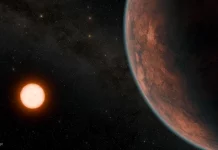
Scientists at the University of Leicester have made a jaw-dropping discovery in a galaxy about 500 million light-years away from our own Milky Way.
They found a small black hole that’s ‘eating’ a star similar to our sun. Every 25 days, this black hole takes a ‘bite’ that’s like gobbling up three Earths worth of the star’s material!
They named this weird action Swift J0230, and it was discovered using a new tool they designed for the Neil Gehrels Swift Observatory.
This tool helps scientists spot bright X-ray bursts that happen when extreme things occur in space.
So, why does Swift J0230 stand out?
Normally, when a black hole pulls apart a star, we see bright flashes that slowly fade away. But this isn’t the case here.
Swift J0230 shines bright for about 7-10 days and then suddenly goes dark, only to light up again roughly 25 days later. It’s like clockwork!
This is special because it’s the first time we’ve seen a sun-like star being slowly consumed this way by a black hole.
Scientists used to think that these kinds of events fell into two categories: those that flash every few hours and those that flash every year or so. Swift J0230 doesn’t fit neatly into either of these boxes.
It’s somewhere in between, acting as a ‘missing link’ that helps researchers understand these events better. Dr. Phil Evans, the lead scientist, called these happenings “repeated, partial tidal disruption” events. In simple terms, the black hole takes ‘bites’ of the star but doesn’t destroy it completely.
The star orbits the black hole in an oval shape, getting very close at times. When this happens, the black hole’s strong gravity pulls away a chunk of the star. This material gets super hot, up to 2 million degrees Celsius, as it falls into the black hole. This heat sends out a big burst of X-rays that the scientists can see using the Swift satellite.
The black hole is surprisingly small for one at the center of a galaxy. It’s only about 10,000 to 100,000 times the mass of our sun. For comparison, the black hole at the center of the Milky Way is 4 million times our sun’s mass!
Scientists are excited because Swift J0230 was found quickly after they started using their new tool. They believe that there are many more of these ‘eating’ black holes out there waiting to be discovered.
Dr. Caroline Harper from the UK Space Agency said the Swift mission continues to reveal amazing things about our universe.
She highlighted how their partnership with NASA has led to these exciting discoveries. She’s excited to see what else Swift will uncover in the future, especially about big events that cause gamma-ray bursts in the cosmos.
So, the next time you look up at the night sky, just imagine: somewhere out there is a small but very hungry black hole taking ‘bites’ from a star similar to our own sun.
And thanks to some smart scientists and their new tools, we’re learning more about these mysterious cosmic diners.
The study was published in Nature Astronomy.
Follow us on Twitter for more articles about this topic.



